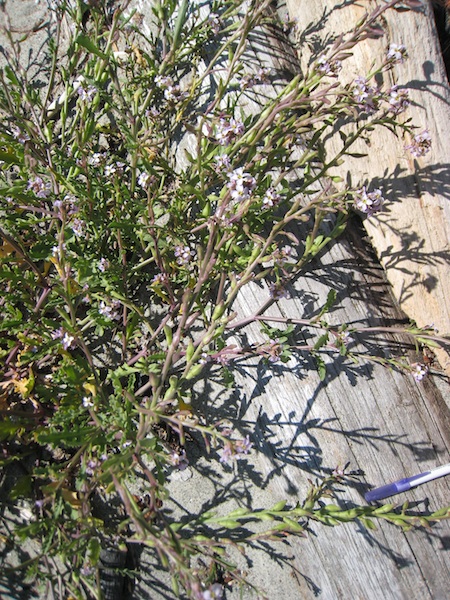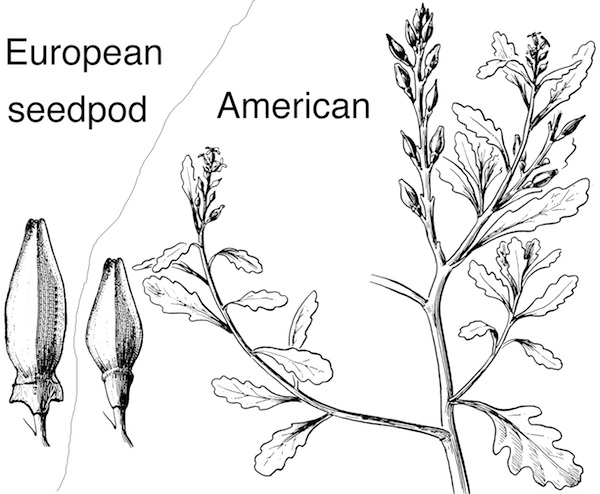| The Sea Rocket is a succulent plant limited to growing on beaches, mostly saltwater ones. It is edible, boasting a strong flavor recalling horseradish or wasabi. This flavor is due to mustard oil glucosides. The Cakile genus is small, of only 7 species. Cakile is based on an Arabic name qaqulleh. In Seattle, our beaches have both the native American (mostly) and the European species. Possibly there will be hybrids sooner or later. |
| First named, in the 1700s, was the European / W Asian Cakile maritima Scop. The native American species is Cakile edentula (Bigelow) Hook., and was distributed originally only on the eastern North American seacoast. It has been wild in Washington State since at least the 1920s. The European species has been in Washington since at least the 1970s. It seems the European is more successful, and will outcompete the American in Washington, as it did in California and Australia. |
| The plants are summer annuals --the European rarely a short-lived perennial. Seeds sprout in March or April, and plants bloom from July through September, or even into November. The flowers are not very showy, light purplish to white. They give rise to plump seedpods, thick-stalked and jointed, as the accompanying illustrations show. |
| The European species I first noticed on Blake Island in 2009; now it is also on Seattle beaches. It has larger petals, longer seedpods with little hornlike swellings at the base, and can have (it varies) more deeply lobed leaves. After you practice, you can identify the plants by a glance. There is nothing else like them. |
| Other names for Cakile maritima are European, Purple, or Common Sea-Rocket. Various plants in the mustard family are called Rocket. |
| People can eat the tender stems, leaves, flower buds and flowers, and young seedpods. Even the roots, like slender radishes, are edible. The plants are imbued with the hot peppery flavor of horseradish, so make an exciting salad addition or potherb. |
| Like most saltwater beach plants, Sea Rocket is not likely to thrive if people attempt to cultivate it in inland gardens. But some people have tried since at least the 1700s. Seeds should be sown in autumn, in a sandy well-drained soil, full sun. No one suggests it as an ornamental. And if grown away from salty beaches, it will taste less salty. Fertilize with nitrogen and growth will be far more robust than on a salty beach. |
Since the American and European species are related very closely, and cross, some botanists may prefer calling the American species a subspecies of the European. In 1826, the combination Cakile maritima var. americana was published.
Back |

Cakile maritima; European Sea-Rocket; photo by ALJ
|

Cakile maritima; European Sea-Rocket; photo by ALJ
|

Cakile edentula; American Sea-Rocket; photo by ALJ
|

Cakile edentula (left) and Cakile maritima (right); photo by ALJ
|

Cakile maritima seedpod (left) and Cakile edentula (right); drawing by Jeanne R. Janish
|

